News, Winter 2009
A resounding success
The 2009 Annual Luncheon
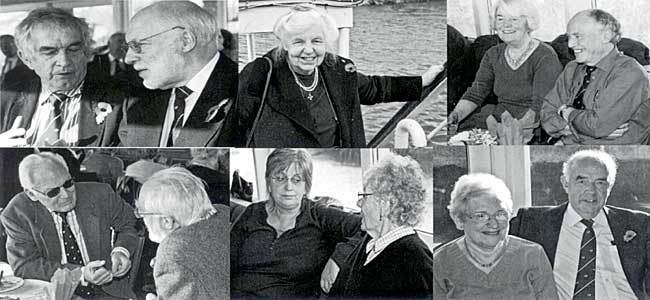
Our annual lunch event took place on 7 November 2009 on a glorious day and with a format which the Society has not previously followed. The usual practice is to hold this event at various venues throughout the county. This year the event was a moving feast because it was held aboard the Nottingham Princess river cruiser.
The day was bright, sunny and warm and those who had some misgivings about the boat likely to be cold soon had their worries dispelled as the warm sunlight ensured the interior was very comfortable.
We gathered at the landing stage of the Park Yacht Inn on Trent Lane and, whilst waiting to board our vessel, were able to enjoy excellent views of the award winning apartment development of River Crescent, Trent Park which is sited on the banks of the river.

Our boat, the Nottingham Princess, is one of a fleet of pleasure boats operating regularly from this location and available for private functions. She is a two deck vessel and our party occupied both decks with our tables attractively laid out for lunch as we boarded promptly at 11.30 a.m. The boat was very clean, tidy and comfortable. There was no queuing at the bar as can happen because there was a bar on each deck and the staff served quickly and efficiently.
Members who were seated on the lower deck were pleasantly entertained by a duo singing a mixture of folk and pop songs which those on the upper deck were unable to hear. However, John Beckett's welcome was broadcast throughout the boat on its PA system and both decks were able to hear Alan Langton as he said Grace before the meal. After the three courses and before coffee, Jim Chettle proposed a toast to the Thoroton Society in an amusing and topical manner and our President, Rosalys Coope graciously responded.
The food was hot, very well presented and served; the staff being most attentive and efficient so that everyone was able to enjoy their meal in comfort and no-one had to wait for service. Leaving the Park Yacht Inn we sailed downstream, enjoying the scenery and identifying the places we passed. The river passes the industrial estate at Colwick and, although the views could not be described as pretty, we were able to enjoy seeing the old sugar factory from a different perspective. The building looked rather sad with its broken windows and dilapidated appearance but the solid brickwork and its proud chimney stood tall.
The Holme Pierrepont Water Sports Centre allowed us to see some slalom canoeing as we drew into the lock to experience the slow fall in water level which allowed us to continue the journey under the railway viaduct at Radcliffe-on-Trent and pass below Radcliffe Cliff to turn around at Stoke Bardolph lock.
When the meal was over members visited friends on each deck and many congregated on the after deck to watch the scenery and enjoy a good natter and exchange of views as is usual on these occasions.
The return journey was as pleasant as the outward one and afforded views of birds such as grebes, swans and, on the buoys at Holme Pierrepont lock, cormorants standing on their individual red buoys.
All too soon we were back at our departure point and had to disembark for our onward journey home. It was timely as the weather was beginning to turn colder.
It was very good to see some members present who are recovering from serious illness and to enjoy their company. As always, the company was excellent and the occasion yet again showed how the social aspects of our Society bring members together in congenial circumstances.
2009 will enter Thoroton lore as the year when we ventured to do something different which proved to be a resounding success for all who attended. Indeed, members were discussing other possibilities for the luncheon than our usual restaurant situations, whether this can be achieved remains to be seen and the 2010 lunch will be held at Blyth in the north of the county.
These events do not just happen and a great deal of work is involved in the planning, booking and arrangements for the day. Leslie Cram formulated the idea of a river cruise in his capacity of Programme Secretary and Barbara Cast, as Society Secretary, made the bookings and seating plan as well as ensuring that all who attended had an excellent day. We owe a good vote of thanks to both of them.
The colour images on the covers, together with the black & white ones inside this issue, give a good flavour of the day and, for members who were unable to be with us, it is hoped provide an encouragement to come and enjoy future luncheons.
Howard Fisher
Recent society exhibitions
National Heritage Day was held on 12 September 2009 when many institutions opened their doors to the public. Our meeting place, The Mechanics Institute in Nottingham decided to have an Open Day and invited all the societies using their facilities to put on small exhibitions. Margaret Trueman and I put on an exhibition for The Thoroton Society. The event was fairly successful but visitor numbers did not really justify the time spent. The lovely weather possibly had an effect with people preferring to be outside.
On 21 September we took the exhibition to the Bramcote Local History Fair. This event was held in the evening and was very successful. We had a lot of interest in the Society and a number of people took our leaflets and programme cards. Margaret and I would like to than John Hamilton for his help on both occasions.
Penny Messenger
W. E. Gladstone (1809-98): The Grand Old Man in Nottinghamshire
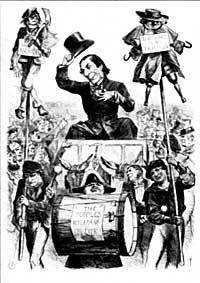
The bicentenary of William Ewart Gladstone's birth, on 29 December 1809, is being commemorated within Nottinghamshire with a series of related exhibitions and public events, to be held between November 2009 and March 2010. Gladstone was first returned to parliament as MP for Newark in 1832 but retained his close connections with the town and county after he retired from the constituency in 1846. Gladstone enjoyed good relations with many of the county's leading families, including the Dukes of Newcastle and Portland. In later life Gladstone was a trustee of the Newcastle estate which gave him a role in the development of Nottingham Castle and the Park estate. Meanwhile his presence at the foundation of University College, Nottingham in 1877, records a direct link between the 'Grand Old Man' (as Gladstone was popularly known in later life) and the history of the University of Nottingham.
The commemorative events begin, appropriately enough, in Newark, with exhibitions of Gladstone related material at the Millgate Museum from 21 November and Newark Library from 25 November. The Town Hall Museum's exhibition, 'The Changing Face of Mr. Gladstone', will be officially opened by Patrick Mercer, MP for Newark, on Friday 27 November. This will be followed by a talk entitled 'Gladstone and the 4th Duke of Newcastle' by Dr. Richard Gaunt, a Thoroton Council member, which commemorates Gladstone's local associations through images and contemporary accounts from the University of Nottingham's Manuscripts and Special Collections Department and the Nottinghamshire Archives. The exhibition, to be held at the Weston Gallery, D. H. Lawrence Pavilion, Lakeside Arts Centre, from 11 December 2009 to 21 March 2010, commences with a private view on Thursday, 10 December between 5 and 7 p.m.
Anyone who is not already on the University's mailing list for Weston Gallery events is asked to contact Manuscripts and Special Collections on 0115-951-4565. A series of talks and events will also be held to accompany this exhibition. Places are limited so please book tickets with the Box Office on 0115-846-7777. Richard Gaunt
Henry Hurd Swinnerton
The name of Henry Hurd Swinnerton is rarely heard in Thoroton circles these days, yet Professor Swinnerton (1875-1966) was the first Head of the Department of Geology and Geography at University College, Nottingham. He was Professor of Geology from 1910 to his retirement in 1946. Away from his more technical papers his most popular book was Fossils in Collins' New Naturalists series, published in 1960 and written when he was in his eighties. So next year marks the fiftieth anniversary of its publication. When I set out to write this little note it was Professor Swinnerton's first, rather modest, book Nottinghamshire, in the Cambridge County Geographies published in 1910, from which I was going to quote - in celebration of its centenary There is a copy of the unaltered second edition of 1920 in the Nottingham Local Studies Library, Angel Row and no doubt copies are in other County Libraries. It is worth seeking out for it does give a concise review of our county 100 years ago. The whole volume is also reproduced on Andy Nicholson's excellent Nottinghamshire History website look under 'Nottinghamshire History Subjects'.
Thoroton Society officers - and what they do
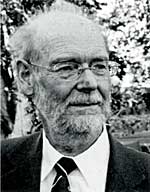
Leslie Cram, who is leaving the role of Programme Secretary.
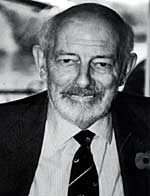
Keith Goodman who has handled the arrangements foi our outings for several years as well as providing many photographs of speakers and events for the Newsletter; Keith is stepping down from the outings post.
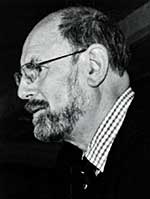
David Hoskins who has taken on the task of arranging our lectures as joint Programme Secretary with Alan Langton who is to handle the excursions. Alan is pictured on the front cover saying Grace at the luncheon.
Following requests from Members for an explanation of the functions of the Society's Officers, our Secretary, Barbara Cast, has compiled the following explanation of the various duties of the individuals concerned.
The Society relies on its Council and officers to keep it active, continually developing, interesting and attractive to members and potential members; also fulfilling its principal aims of study and research. Over the last couple of years there have been a few changes and we felt it would be helpful to let members know who does what, and who you should contact if there are enquiries, or even what role you might feel you would like to take on at some point. The business of the Society is undertaken by its Council, which in turn delegates its day-to-day business to the Standing Committee or to one of the officers which make up the Standing Committee. The Society has no employees; all tasks are undertaken by volunteers.
The Chairman, John Beckett, has a leading role in guiding the direction which the Society takes: he chairs Council and the Standing Committee and is involved in all aspects of its work, including its publications. The Editors, Richard Gaunt (lead editor), Keith Challis (archaeology) and Adrian Henstock (Record series), together with the Publications Committee, determine and manage the Society's Transactions and Record Series publications.
The Hon. Secretary, Barbara Cast, has an organisational and administrative role, arranging Council meetings, the AGM and the annual lunch. She also compiles the annual report, draws up guidance for officers (called the Thoroton Year) and responds on behalf of the Society to national and local matters of concern or interest. If in doubt as to where to make enquiries, Barbara is the first port of call and will direct queries to the appropriate person.
The Hon. Treasurer, John Wilson, is responsible for ensuring the Society is on a sound financial footing and reports regularly to Council and the Standing Committee on the current situation. He manages all financial affairs for the benefit of the Society, makes sure all payments etc. are made and draws up the annual accounts.
Howard Fisher is our Newsletter Editor and under his editorship this paper gets more and more attractive and informative. He welcomes articles and ideas for the Newsletter.
Our Circulations Secretary, David Bagley, does an excellent job in ensuring the Newsletter and information on events is sent to every member in good time.
We now have a dedicated Membership Secretary, John Hamilton, who deals with membership enquiries and applications and also ensures that our leaflets are displayed as widely as possible.
The arrangements for drawing up and managing the annual programme are in process of change: Leslie Cram, who has been masterminding the programme for a good number of years, has decided to relinquish the role so that he can concentrate on other things. The Society is most grateful for all he has done to ensure an excellent programme is provided. We will, from January, have a duo of programme secretaries with David Hoskins taking responsibility for lectures and Alan Langton for excursions.
We are also most fortunate to have an excellent webmaster in Andy Nicholson who keeps our website up to date and looking exceedingly attractive and professional. There are also representatives to undertake specific oversight roles on county and city planning, archaeology, and to sit on various bodies relevant to the Society's interests. They report back to Council on a regular basis. The Society is indebted to the Lecture Team of Peter Reddish, David Hoskins and to Margery Penn and Elizabeth Robinson for their invaluable input to the lectures; also to the bookstall team of Penny Messenger, Margaret Trueman and Philip Jones.
This is not a comprehensive list of all those who play important roles in the Society's activities but should give a fair guide to who does what.
Making history: 300 years of antiquaries in Britain
Currently showing at Lincoln The Collection, Danes Terrace, Lincoln, this exhibition contains unique treasures from the Society of Antiquaries of London. Guest curated by Dr. David Starkey, the exhibition explores the creation of the nation's heritage over three hundred years since the founding of the Society in 1707. Rarely seen objects such as the Lindsey Psalter, a lock of Edward IV's hair and part of a Roman bronze equestrian statue found in Lincoln. These will be displayed alongside objects from the museum's own archaeological collections as well as some more recent finds to provide a narrative illustrating milestones in the discovery, recording, preservation, interpretation and communication of our past, both nationally and regionally. Associated events include Lincolnshire Saltmaking through the Ages (10 December at 7 pm); The Discovery of Roman Lincoln (15 December at 7 pm); Antiquarian Heraldry (1 December at 1 pm); Stained Glass Workshop for Beginners (28 November 10 am to 3.30 pm) and Stained Glass Workshop for 12 to 18 year olds (12 December 10 am to 3.30 pm). Details at makinghistory.sal.org.uk and www.lincolnshire.gov.uk/eventDetails.asp?Eventcode=49449.
East Midlands Climate Change Workshop
Climate change workshop was held in the county last July in the first part of which the group looked at scoping the the range of climate change impacts on the historic environment. The matrix of impacts has now been developed to include detailed comments and contributions from participants. This is available from the workshops page of the CBA website at www.britarch.ac.uk/conservation/climate/workshop where there is a link to the Nottingham Declaration website carrying details of the workshop and its outputs.
Joint regional priorities for leadership on climate change and the historic environment - based on the workshop findings - are expected to be adopted by the East Midlands Heritage Forum.
- Access for owners, their agents and contractors to advice and guidance on the management of historic assets in new climatic conditions
- A robust, shared and simple methodology for the assessment and registering of risk to heritage assets from new climatic conditions, and from proposals for adaptation and mitigation
- Guidance for policy makers to ensure regional and local plans address vulnerabilities and opportunities of the historic environment (e.g. On NI188, the wealth of case studies from the workshop, and on issues to be addressed in a further workshop)
- Making a clear case, widely accepted, for the positive contribution that utilizing and reusing historic assets can make in adapting to climate change and reducing carbon emissions.
A summary report of the event and next steps will be published during the autumn.
The Mansfield and Basford Poor Law Union letters: an opportunity
There are thousands of underused and unlisted letters, memos and reports from the Basford and Mansfield Poor Law Unions held at The National Archives, Kew. The National Archives is running an archival project called 'Living the Poor Life' which involves groups of people with an interest in local, family and social history.
There are currently around 200 volunteer editors, from all over the country, working on around 105 volumes of nineteenth century poor law correspondence records. These volunteers download digital images from the project website and then write up catalogue entries for the records which then go into the electronic catalogue making them word searchable. The document images are provided online at no cost.
Within the records are local allegations of cruelty to individual paupers, instances of workhouse disturbances, accounts of political and Chartist activities, letters referring to children in the south sent to the northern mills, reports on medical matters, accounts of those suffering breakdowns and other mental health problems, and details of thousands of paupers: those who did not share in Britain's position of the 'Workshop of the World'. These records are essential for family and local historians and anyone interested in the history of poverty, pauper education, public health, labour matters and wages.
TNA supplies scanned copies of the documents, full training and support as well as helping to publicise the 'hidden histories' found by volunteers.
To volunteer or request further information please contact Dr Paul Carter, c/o The National Archives, Kew, Richmond, Surrey, TW9 4DU or via email: paul.carter@nationalarchives.gov.uk. Thoroton Council member, Philip Jones, has ben involved with the Southwell Union Correspondence Project run by TNA for several years and has found it a very worthwhile project.
Mapping the moment: performance culture in Nottingham, 1857-67
This newly launched project which can be found on the web at www.nottingham.ac.uk/mapmoment investigates the performance and entertainment culture of Nottingham in the mid-nineteenth century. In a collaboration between theatre history and geographical information science, based at the University of Nottingham and supported by funding from the Arts and Humanities Research Council, an interactive map of Nottingham has been developed which will enable users to find out about the kinds of performances and entertainments which were happening in the town, and about the audiences who might have attended those performances. Working in partnership with local archives, museums and libraries, the site enables digital access through the map to a large amount of material on entertainment and social culture which has previously been difficult to access. The material has been collected from newspapers, diaries, playbills and other sources, including the 1861 population census.
The map of Nottingham which forms the centrepiece of the website is designed to make the data collected through the project accessible to local historians and researchers in a context which stresses the inter¬connection of sites of entertainment - and the performances themselves - within the boundaries of the nineteenth century town. We hope that in doing so our research helps to recover a sense of the social and cultural landscape through which spectators of performance in Nottingham would have moved on their way to the theatre, lecture rooms, concert halls, or the town's Goose Fair during the years of the study.
The period 1857-67 was chosen for the project because it was a time of change and renewal in Nottingham. The 1850s and 1860s saw the town's population increase by 29,000 and the housing stock nearly double. There were also important changes in the performance culture of the town, registered in particular by the building of the new Theatre Royal at the top of what is now Market Street, itself replacing the much narrower 'nuisance' of Sheep Lane, and the regeneration of the surrounding area.
Joanna Robinson
CBA East Midlands Members Research Day
The East Midlands branch of the Council for British Archaeology is holding a Members' Research event on Saturday, 27 March 2010 at Lowdham Village Hall. There is a huge amount of work being conducted by local archaeological and historical groups and it is hard to keep up with the range and variety of projects conducted over the whole of the East Midlands area. CBA East Midlands in conjunction with the Bingham Heritage Trust Association, are hosting a 'Members' Research Day' where all groups are invited to attend to present the results of their research. Formal spoken presentations, display boards and posters are all welcome. For further information please contact D. Garton, 12, Collington Street, Beeston, Nottingham, NG9 1FJ or daryl@dgarton.plus.com.
Thoroton's Antiquities - 1st Edition
That is believed to be a first edition of Thoroton's Antiquities of Nottinghamshire, said to be complete and in very good condition, is for sale. The contact number is 01522-703786. No price has been quoted.